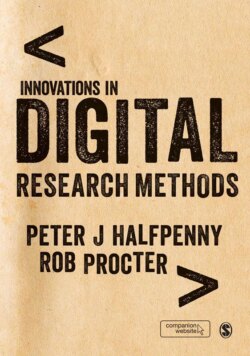Читать книгу Innovations in Digital Research Methods - Группа авторов - Страница 52
На сайте Литреса книга снята с продажи.
2.3.6 Data on Social Behaviour
ОглавлениеIncreasingly, social science research is attempting to analyse people’s actual behaviour alongside self-reports of their behaviour. In part, this is driven by evidence that respondents often misreport their behaviour. For example, many more people will state when asked that they voted in an election than actually did (Pattie et al., 2004) and many more report that they recycle household waste than actually do in practice (Whitmarsh, 2009). This might be a result of recall failure, or of social desirability bias reflecting perceptions of the civic duty to vote or be environmentally friendly.
As we have outlined above, there are different types of data sources that capture actual behaviour and data relating to real time activity is of great potential value here. For example, in relation to well-being and health, consequential data such as consumption information and administrative records of gym attendance and mobile tracking data on individual movement and exercise can be used. Mobile application data can also track social network activity. See, for example, Bucicovschi et al. (2013) who used data provided by the communications company Orange to map connections between 1216 cell phone towers. The volume of calls passed from one tower to the next revealed ‘communities’ and who talks to whom. Not all such data are easily available for social science research, however, and access is often reliant on effective partnerships between researchers and data holders in the private sector.
We consider a hypothetical example of how such a joined-up data approach may be designed. A social science researcher interested in anti-social behaviour has a range of possible data sources to use. They could combine consequential administrative data on anti-social behaviour with intentional data from the British Crime Survey. They might also analyse social media data from police forces and officers. As mentioned above, a police force recently posted tweets of all incidents dealt with in a 24-hour period. Example tweets include:
Call 215 stolen vehicle heading towards Manchester #gmp24 Thursday October 14, 2010 5:03;
Call 216 harassment report in Bolton #gmp24 Thursday October 14, 2010 5:03;
Custody update 101 in police cells at 5 am #gmp24 Thursday October 14, 2010 5:04;
Call 218 neighbour dispute in Wigan #gmp24;
Call 219 nuisance call #gmp24;
Call 220 aggressive shoplifter held at supermarket in Stockport #gmp24.
A social science researcher could code such data for: incident, time, location and language. Follow-up analysis could be conducted in terms of outcome and administrative data on legal prosecution and offender rehabilitation. Qualitative research with people who live in the area and with police officers could also be conducted. Comparisons with other police forces could be made. As outlined above, a multiple data type approach to social science research may create a step change in the explanatory power of research. Other applications for analysing digital data, including social media data, are being developed such as looking at text message and use volumes to anticipate and monitor events and how people are responding to them.
As well as these various forms of data regarding social behaviour, primary intentional type data are increasingly being generated using experimental techniques. These methods involve comparing interventions on test and control groups. The UK Government is pushing forward this approach with its Behavioural Insights initiative (Cabinet Office, 2011). Examples include: the use of information interventions in relation to voting and recycling, public recognition in charitable giving, the use of peer effects in voting and tax payment, and choice framing in relation to organ donation. We consider this kind of data in more detail in Chapter 3.
